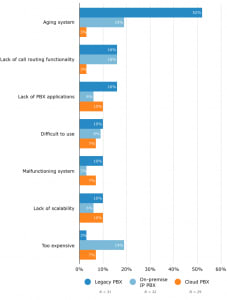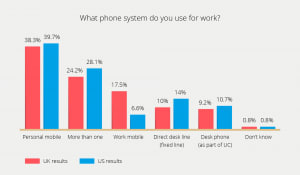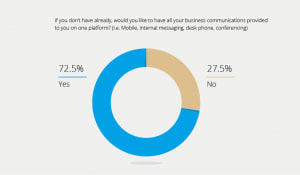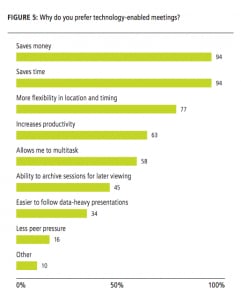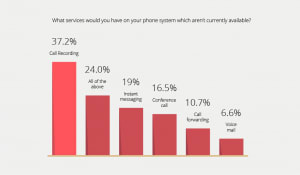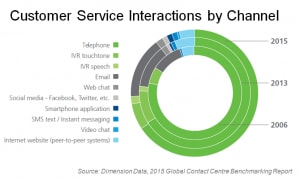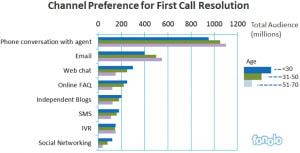
Redcentric Records with Dubber
As the big telecom providers phase out traditional public switched telephone network (PSTN) functionality, businesses are looking for a modern solution to their telephony needs. A SIP trunk allows business telephone systems to operate using an internet connection rather than a traditional phone line. Session initiation protocol (SIP) is essentially a language that allows phones and other telephony devices to talk to each other. It is a standard communications protocol for initiating interactive multimedia sessions across a data network. This protocol is used for creating, modifying, and terminating sessions. A trunk is a line or connection that is able to transmit multiple signals simultaneously. A SIP trunk is able to combine data, voice, and video in one connection.
With Verizon planning to shut down its integrated services digital network (ISDN) in the USA and Germany also phasing out ISDN by 2018, and BT announcing that from 2020 ISDN and PSTN circuits will no longer be available to purchase, moving to an internet telephony service will soon be essential. Instead of traditional PSTN, calls operate through voice over internet protocol (VoIP) through one point of entry – the internet connection. SIP trunking occurs between a private domain, connected to your network, and the public domain, which is the responsibility of your internet telephony service provider (ITSP). This interconnection allows for VoIP and media streaming to take place.
A manual telephone switchboard.
Often there is no physical hardware required for a SIP trunk connection although, depending on how the trunk is presented, a private branch exchange (PBX) or session border controller (SBC) may be required. Installation uses a business’s existing internet connection, removing the need for traditional phone lines and the costs associated with maintaining them. As the telephony service is not bound to a physical phone line, you can easily move offices and keep your phone number.
Multiple phone lines can be replaced by one SIP trunk, which allows for scalability that can adapt to the growth of a company. VoIP is also more reliable than traditional phone lines as the quick and easy forwarding of calls to mobile phones provides insurance in case of system failures.
When looking at SIP trunking for your business, additional benefits such as number provision and call recording should be considered as well as cost. With SIP trunking, features such as multiple phone numbers and call forwarding that aren’t available through a traditional telephone line can be added easily.
SIPREC
Traditionally, call recording through PSTN captured voice conversations as audio files on the trunk side of a network infrastructure – the telco-facing portion on the outside of the internal phone system. Session initiation protocol recording (SIPREC) is a way of allowing calls to be recorded securely, without interception. SIPREC defines the architecture of call recording, including the call flows and metadata associated with it.
The internet engineering task force IETF has created a framework for SIPREC that identifies the two parties involved in call recording: the session recording client (SRC) and the session recording server (SRS). SIPREC occurs through the session border controller, which is a device that sits between businesses and their network provider. A SIP invite contains specific metadata for processing call recording that contains information about the call and participants.
Where traditional call recording would use hardware to tap into a dedicated line in order to capture the communications, no such equipment is required for SIPREC as the devices that handle the SIP trunk can also enable recording through SIPREC. Using SIP trunks enables SIPREC to be implemented quickly and easily, allowing a call recording solution such as Dubber to capture communications.

With online interaction dominating the modern world, a phone call feels special. Phone calls are reserved for the important stuff – for the decision that needs to be made, for the question that we want answering urgently – we pick up the phone when we just need to get things done.
Listening in
We can see this idea reflected in how customers contact companies when they need assistance: research by eConsultancy found that a phone call was the most commonly chosen method of communication at 61%. When looking for online assistance, 71% of customers wanted help within 5 minutes or less (see chart below). The majority of customers looking to buy also choose to call a company rather than contacting them online. Both Google and xAd, two of the leading digital advertising networks, found that a click-to-call option on ads was highly successful – with 51-62% of users choosing this option.
Source: eConsultancy
On top of the immediacy offered by a phone call, there is science behind why verbal communication is so effective: hearing is the fastest sense, with sound taking only 10 milliseconds to reach the brain compared to 13-80 milliseconds for sight, according to researchers at MIT,
With customers 11 times more likely to complain over the phone than via the internet, according to research from Arizona State University, these phone calls are a valuable opportunity to turn a negative experience into an improved relationship. Customer interactions that take place over the phone create a much better opportunity for a meaningful connection. Your customer is right there, willing to speak to you, and you can answer any questions they might have immediately. Up-selling and cross-selling also comes much more naturally over the phone. Only a face-to-face conversation could possibly be better.
Reading between the lines
Written communication can be open to interpretation. It’s the very reason for the enduring magic of books, but it can result in misunderstandings in the corporate world of hurried emails. Without the indicators of tone and meaning, simple sentences can be misconstrued to drastic effect. When clarification is needed over the phone, you can get an answer immediately. Complex technical queries are always best discussed with a call as the instant feedback can alleviate confusion quickly, whereas a series of emails might only further complicate things.
With a phone call, you can hear the emotion of the speaker’s voice – their intonation and volume of speech can often say more than their words. Customer service agents can tell if a customer isn’t fully happy with the resolution of their complaint, while sales agents can get a better sense of how to entice a new client.
Measuring the success of phone calls
The importance of phone calls is clear, and because of this customer service agents who excel at building relationships with customers are more valuable than ever. However, contact centre workers can feel like they lack objectives and that their work can’t be measured. In order to provide customer service agents with reports on their success, a call intelligence solution such as Dubber’s Zoe can be utilised to conduct sentiment analysis of calls and measure the customer’s experience throughout the conversation. Not only does this give workers valuable feedback on their work and progress, their supervisors receive an insight into their interactions with customers and can use this information to improve their work practices and train new members of staff effectively.
The benefits of email and instant messaging are the paper trail that they leave behind. With a call recording solution, such as Dubber, that provides transcripts of your conversations, you can have all the benefits of phone calls with the reassurance that you can track and record your communications.

Dubber and Macquarie Telecom Sign Call Recording MSA

Dubber Annual Report 30 June 2017

Virtual reality (VR) allows you to be transported to real or imagined locations instantly and can connect you to people all over the world. VR users hit 50 million in 2016 and the number of active users of VR is forecast to reach 171 million by 2018. The graph below shows how revenue has grown and is predicted to grow over the next few years. 360-degree video is already available on platforms such as YouTube and Facebook and continued investment from these companies and others including Google and Microsoft mean that VR technology is becoming more affordable every day.

Source: Superdata
The technology is set to transform a number of industries and affect on the way we work and interact with the world and each other. Developments in VR mean that live events such as concerts or sports games can be experienced from your sofa. A global audience can be reached from one venue with the help of a few cameras and some technology. Users can access live streams through VR headsets but also through their browser or mobile app.
A seamless experience
To create a 360-degree video, visual data from multiple cameras must be pieced together to create one video. Post-production of VR content begins with stitching and blending to create one seamless sphere of visual content. VR has continued to improve since its conception and now features immersive effects such as audio that matches the user’s visual experience so accurately that when a user looks away from something, the audio diminishes. Recording using binaural sound is key to this feeling of ‘presence’. For a successful VR experience, and a feeling of true presence, the stitching technology used to create the 360-degree environment must be of a high enough quality to produce a seamless experience.
The future of VR
Tech leaders are predicting that VR will compete with television in the future and are investing in livestreaming services that aim to distribute 360-degree VR content to users around the globe. Just as the internet has changed the way we consume media such as news articles, VR is expected to do the same to television. This entertainment value could be seen as a key area of investment for telcos looking to create a new revenue source after the decline in growth from voice, texts and, most recently, data.
Industry specialists such as CNET founder Halsey Minor believe that VR will be the next stage of growth for the content industry, while Goldman Sachs have stated that VR and AR have the potential to become the next big computing platform. Goldman Sachs have outlined their predictions for VR and AR use in 2025, which can be seen in the graph below. The World Economic Forum sees AR and VR as technologies that can transform daily life with their time and cost saving benefits. This growing industry should be capitalised on by any telco wishing to stay relevant in the future.
Goldman Sachs predictions for VR and AR use in 2025
An example of a telco that is investing in VR is SK Telecom, which is commercialising its 360-degree VR live broadcasting capabilities and planning to open its application programming interface (API) so that individuals and small content developers can create their own 360-degree live VR experiences.
At this stage, the development of VR is very experimental as challenges are identified and overcome. Poor internet speeds can impact the VR experience through heavily compressed images and the strain that VR will put on networks is an area of concern. Network capacity needs to be an area of investment, particularly at the user end of the journey, as VR requires around five times more bandwidth than HDTV as well as the low latency that is essential for a fully immersive experience. If users do not have the correct requirements, content will need to buffer and be stored locally – creating delays and limiting the interaction capabilities of the VR experience.
The next steps for VR will take the experience mobile. Immersive live VR broadcasting will work in tandem and become more widespread with the development of 5G due to the large bandwidth and low latency that are required for streaming. Network providers will play a key role in the realisation of VR, ensuring high quality connections to allow for a seamless immersive experience.

Hosted telephony has gained popularity and coverage recently, with its cloud base appealing to forward thinking enterprises and press alike. The chart below shows the growth of both managed and hosted systems, with on-premise PBX experiencing negative growth. However, research undertaken by communications analyst MZA has shown that most small businesses still use PBX rather than making the move to hosted telephony. There are four main factors to consider when choosing between the two solutions, which are outlined below.
Source: Synergy Research Group
Cost
Hosted telephony largely appeals to both small and large businesses due to the lack of CapEx required to implement the system. There is no hardware necessary, which reduces the storage space required as well as power costs associated with running servers. With on-premise PBX options there are also installation costs on top of hardware expenditure. Larger organisations will have greater CapEx, as costs only increase with the size of the hardware required.
However, monthly subscriptions for hosted telephony can work out more expensive over time, depending on the services and the size of the enterprise. Considerations need to be made regarding the features required by the business, as there may be extra costs that are not included in basic hosting packages. The chart below shows the top 7 reasons that SMBs look to change their system, with the results separated by their current solution, giving an idea of the considerations that should be made when deciding on a system.
Software Advice’s survey of SMBs and their phone systems
Time
As well as installation costs, the time required to implement an on-premise PBX solution is an inconvenience. Cloud solutions offer the advantage of rapid deployment, meaning installation costs are virtually eliminated by the DIY approach to implementation. When choosing a telephony option, installing a new infrastructure is a significant commitment. PBX solutions will need to be updated over time, and replacing hardware or enhancing features can take weeks to integrate. These changes can often lead to communications downtime that will need to be scheduled to reduce inconvenience as much as possible.
Hosted solutions can be implemented alongside existing communication systems. The most hardware that will be required is the phones themselves. Software updates are maintained by your cloud provider, meaning you stay constantly up to date.
Flexibility and scalability
The case for hosted telephony is certainly bolstered by the flexibility and scalability that it offers. Just as hosted telephony can grow alongside a business, it can also be scaled back. This can reduce monthly costs immediately, in contrast to large CapEx that will have already been paid in the case of PBX.
Security
With hosted telephony you have the added reassurance of reliable redundancy. Depending on the provider, you may not have immediate access to all of your data but you will have the guarantee that it will be stored securely with recovery solutions. The advantage of on-premise PBX systems is the immediate access they offer, but recovery measures are often so expensive that only larger enterprises are able to justify the cost of this level of security.
To decide which option is right for your business you need to consider not only pricing, but what your company needs from a telephony system. Looking to the future and anticipating how these needs might change as your company grows is just as important as the immediate considerations of cost and convenience.

We recently published the results of our survey of SMBs in the US, which showed what small businesses are missing from their current communications solutions. After uncovering some interesting results we conducted a comparison survey; this time of UK businesses.
Accounting for a large percentage of employees in the UK – 48% according to the report SMEs and Flexible Working Arrangements – SMBs differentiate themselves from larger enterprises through their agility and ability to respond to changes within their market quickly and easily. A cohesive communications strategy, one that encourages collaboration and productivity within the company as well as streamlining external conversations, gives smaller businesses the opportunity to triumph over larger companies that may struggle to adapt.
By consolidating their communications, across telephony, email, and instant messaging, small businesses are able to synchronise conversations that happen remotely and also out of office hours. With a similarly small number of SMBs in the UK currently using a unified communications (UC) solution – 9.2% in the UK compared to 10.7% in the US – the potential for telcos is clear.
Mobility is key across UK and US
Much like the findings of our US survey, personal mobile was also the most commonly chosen answer to the question ‘what phone system do you use for work?’ by participants of the UK survey, with 38.3% choosing this option compared to 39.7% of US respondents (see chart below). To keep workplace communications cohesive, a UC solution with mobility is essential for small businesses where workers use their personal mobiles so much. Small businesses may have limited office space, so having the confidence that their employees can have all the functionality of work available on their own devices is of great benefit. Getting employees to use their own devices may also be more cost effective for smaller businesses.
We looked at the different services that SMBs used as well as their phone system. In the UK instant messaging was the most popular choice, with 71.7% of respondents communicating in this way, closely followed by voicemail at 67.5%. This is unsurprising given the growth of Slack, which has grown to 5 million daily active users from 4 million since only October 2016. Instant messaging was slightly less common in the US with 57.9% using this service, while 79.3% of respondents said that they used voicemail. The benefits of consolidating all of these communications include an increase in productivity as conversations can be found in one place.
Interestingly, when asked if they would like to have all business communications, including mobile and deskphone as well as conference calling and internal messaging, provided in one UC platform 64.2% of UK respondents said yes, compared to 72.5% of US participants (see chart below). This is still a significant majority and one that should be pursued by telcos.
A flexible approach to work
Increasingly, employees have come to expect the flexibility to be able to work from a range of locations, at a time that is convenient to them. According to a Citrix-commissioned report by The Work Foundation at Lancaster University, over 50% of businesses in the UK are likely to have a flexible working policy in place by the end of 2017. This flexibility boosts the happiness of employees and can result in more efficient working with less time spent travelling if employees can work from home and remain connected with the rest of the team. In fact, research by Vodafone found that 83% of respondents to their extensive workplace survey said that adopting flexible working has resulted in improvements in productivity.
A unified communications as a service (UCaaS) model utilises cloud infrastructure in order to provide the kinds of features that were once only available to larger enterprises, and through a lower cost service that is quick and simple to deploy. Cloud-based solutions also offer a higher security level that can defend against cyber attacks. Any solution will need to serve a variety of devices to fully integrate all employees but will be better placed to adapt to updated technology in the future with intuitive software and the automatic rollout of new features.
Additional services
In a similar result to our US survey, the additional service that SMBs in the UK wanted most from their service provider was call recording. An even higher percentage than the US, 42.5% compared to 37.2% of US respondents, chose call recording as the service they would like to add to their phone system (see chart below). Call recording is becoming increasingly important to small businesses as regulation and compliance develop as issues for more industries.
Not only do UC solutions offer synchronised conversations, their enhanced reporting capabilities can be instrumental for business understanding and growth. Call recording can help with training new team members and the data captured can form the basis of reports that inspire improvements in business practices.
Another opportunity for business development is the integration of a UC solution with existing CRM systems. This can add value as customer details become a part of the communication process, creating an informed approach that can improve relationships and make conversations more efficient.
Not only would a UC solution create a simplified and cohesive approach to workplace communications and increase interconnectivity between employees of small businesses, the potential for increases in productivity and efficiency is great. When integrated with existing CRM systems and used to inform business practices, a UC solution can provide previously unrealised opportunities for growth and development.

With an evolving business culture that increasingly requires flexibility from workers, solutions have developed that enable businesses to stay on target even when employees are working remotely, from their own devices, and out of office hours. Unified communications (UC) solutions do just that: synchronising conversations across devices and allowing workers the flexibility they need to keep up. SMBs are now looking for UC solutions which were only available to large corporations a few years ago. We’ve surveyed 120 SMBs in the US and found some interesting results.
Investing in communication
Communication is an important part of any business, but with tighter travel budgets affecting SMBs more keenly (a recent study by Forbes found that 59% of SMBs surveyed were travelling for business less frequently than they had been at the beginning of 2008, with 37% saying that they were travelling much less frequently) developing adequate alternatives to face-to-face contact is crucial. Improving communications allow relationships to be maintained from a distance, removing the need to be constantly on the road but in a slow and precarious economy, contact with clients is vital to nurture relationships and retain business
The demand for a unified communications solution is increasing due to the productivity and cost reduction benefits associated. Our survey of 120 SMBs across the US showed that while only 11% said they had a UC solution in place, 73% of respondents said that they wanted a service that consolidated all of their communications into one platform, showing a huge opportunity for UC growth. Simplifying the ways employees talk to each other and external contacts brings with it increased efficiency and a feeling of interconnectivity that is vital in a small business.
With 84% of respondents stating that they use the telephone as a business tool either some or all of the day, it is clear that this is an important channel for their company communications. However, significant percentages of respondents also noted their use of instant messaging and conference calls: showing that while traditional voice calls remain important to businesses, communication is branching out to other channels. Especially when sharing data or imparting information that is better presented visually, technology-enabled meetings such as web-conferences are a growing channel for businesses to engage with their customers through. More than half of SMBs surveyed by Forbes said they had increased their use of web-conferencing, videoconferencing, and teleconferencing since 2008 – citing time and money saving benefits as the main reasons for their choice of communication channel and also flexibility of location and timing (see graph below).
Source: Forbes
Mobile workers
SMBs are likely to employ mobile workers who need more flexibility than a traditional desk phone can offer. They frequently work across multiple devices and out of the office and require a communications solution to match if they want their conversations to remain cohesive and organised. When asked what phone system they used for work, personal mobile was the most common choice for respondents of our survey – showing that SMBs require a UC solution with mobility to ensure their communications are synchronised.
Employees experience this level of constant connectivity in their personal lives and they have come to expect this from their work communications as well. The risk of continuing without a UC solution in place is that employees, frustrated by workplace communication channels that lack flexibility and performance, use their personal accounts for external communications. This can cause difficulties concerning security and compliance. We have written before about the rise of BYOD and the challenges it brings but in certain industries this approach just isn’t feasible. In its place, a UC platform that is both available and secure is essential. This type of solution, which included features such as call recording and mobility, was once only available to large enterprises but is now available for businesses of all sizes. Telcos now have a unique opportunity to collaborate with platforms such as Dubber to offer these services to their SMB customers who are ready to take advantage of this additional functionality.
The most popular choice of service that wasn’t currently available to the SMBs surveyed was call recording, with 37% selecting it as a feature they want from their service provider, showing a key area of growth that telcos can capitalise on. Call recording is becoming ever more important as regulation and compliance become key for increasing numbers of industries.
The obvious solution for the communication needs of SMBs is a UCaaS model, which can provide features previously only available to larger enterprises, but with much lower costs. Using cloud infrastructure is beneficial to many aspects of businesses, from CRM solutions to data storage, due to its scalability and security, and its future is in communications. Native cloud solutions offer much better security than systems hosted locally and can grow or shrink alongside a business. By consolidating all communication; from telephony to email, via instant messaging, into one integrated service, SMBs can connect their employees with a cohesive working practice.
If you’re one of the SMBs that would like call recording on top of your UC platform, then get in touch

While the days of holding the line while you wait for an available support agent might seem far from over, call centres have evolved since their conception with the emergence of new technology. Now more commonly referred to as contact centres, as communications between consumers and customer service advisors are no longer confined to calls, here we examine how they have adapted to the modern age.
Please hold the line
Traditional call centres used an automatic call distributor (ACD) to distribute incoming calls to agents using a first in, first out (FIFO) system. Modern contact centre solutions now have virtual queuing systems that allow customers to receive callbacks instead of remaining on the line while they wait for an operator to become available. Either a virtual placeholder takes the customer’s position in the queue, or a scheduling system allows customers to choose a time and date in the future at which to be called back.
New technology allows for continuous improvement of customer service. Interactive voice response (IVR) is a technology that utilises speech recognition and keypad tones in order to direct a call to the most suitable advisor using information supplied by the customer. Where traditional ACDs could only play a greeting and queue calls using the FIFO system, IVRs can profile a customer and reduce call transfer and queue times. Callers speaking different languages can be routed to an appropriate agent based on their language preference. With more sophisticated IVR, different approaches can be tested and refined to adapt to the customer’s response. Conversational IVR can even greet customers by name for a personal touch.
Adapting to the modern consumer
Historically, customer support has been delivered through call centres but today modern contact centres use computer telephony integration (CTI) to communicate through a variety of channels including online chat, forum style support ticket platforms and social media. The chart above shows how customer service interactions have changed since 2006. This immediacy and flexible approach is something that has come to be expected by the modern consumer. Where once customer advisors were only required to have excellent verbal communication skills, now their writing and adaptability is being put to the test. The chart below shows preferences in channel by age group.
Source: Fonolo
For instance, Akixi, a leading provider of cloud based call management and analytics allows businesses to improve their sales performance and deliver excellent customer service. They have recently partnered with Dubber, creating the potential for limitless applications of call recording and intelligent call analytics in one fully comprehensive unified communications (UC) package. Like Dubber, their solutions offer unlimited scalability, no hardware limitations, and rapid deployment.
Speech analytics software, such as Dubber’s Zoe, allow companies to identify repeated problems by looking at commonly used phrases and analysing the sentiment of phone calls. Complaints can automatically be picked up and forwarded to development teams to improve future products and services, while customer advisors who consistently turn complaints into positive outcomes can be identified through sentiment analysis.
With communications solutions now being integrated with CRM systems, the data generated from contact centres can help to build an informed profile of each customer. Mondago, who provide computer telephony software, specialise in providing UC solutions that are designed to be integrated with CRM systems. As repeating information is frustrating for the customer, services such as Mondago’s Go Integrator feature screen population, which allows an advisor to see all their available information, create a much more efficient way of working.
An integration between Mondago and Dubber, enables their Go Integrator product to automatically pause and resume call recording with Dubber’s cloud based service. This is essential for remaining compliant with PCI regulations surrounding the protection of payment card information. Again improving productivity in contact centres and enhancing data security of consumers.
Not so distant future
The introduction of session initiation protocol (SIP), which allows for multimedia communications, means that calls do not have to be confined to only voice. In the future, IVR can be extended to IVVR (interactive voice and video response), giving the option of video calls with customer service advisors. This will allow systems to read customer emotions by analysing facial expressions, and can also use facial recognition to identify and greet callers.
In place of security questions and difficult to remember passwords, video calls can use biometric identifiers such as iris scans to prevent fraud. Where customer emotions were once identified by an advisor’s sympathetic ear, sentiment can now be detected by software that can enhance customer understanding. The value of being sensitive to the needs of the customer still remains, but the emergence of new technology allows the modern day contact advisor to do their job more efficiently. By integrating IVR with CRM systems as well as workforce management systems, customer service has the potential to be completely transformed into a proactive element of business development.




